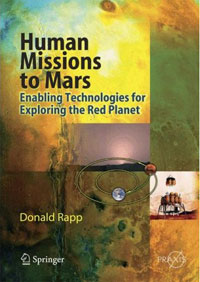Review: Human Missions to Marsby Anthony Young
|
| The last chapter is controversial, as it casts serious doubts on NASA’s approach for a human mission to Mars succeeding before 2080. Why? “Unfortunately,” Rapp states bluntly, “long, sustained expensive technology developments are rarely carried through to completion at NASA.” |
Rapp rightly believes any successful human mission to Mars must be preceded by a proven, long-term human presence on the Moon. He devotes a chapter to NASA’s current plans for returning astronauts to the Moon to resume and expand lunar exploration, and carefully critiques those plans. (Project Constellation would include international partners). NASA is developing Ares 1 and Ares 5 to be the launch vehicles employed for Project Constellation in future human lunar and Martian missions. Many technologies and virtually all equipment must be validated in a future human lunar exploration program before being considered for use in a human Mars mission.
The last chapter is controversial, as it casts serious doubts on NASA’s approach for a human mission to Mars succeeding before 2080. Why? “Unfortunately,” Rapp states bluntly, “long, sustained expensive technology developments are rarely carried through to completion at NASA.” Advanced technologies—enabling technologies as Rapp calls them—are at the core of a successful human mission to Mars. Nevertheless, Rapp believes one day these technological hurdles will be cleared and the financial burdens met. The nations of the world would benefit in ways tangible and intangible from human missions to Mars. Rapp includes three very comprehensive appendices covering solar energy on the Moon, solar energy on Mars, and water on Mars.
Human Missions to Mars is hardbound, and Rapp’s use of supporting formula, graphs, and technical illustrations (coupled with its rather steep cover price) make it clear that this volume is meant to be used as a reference book in research institutions, technical libraries, and scientific organizations. However, Rapp’s engaging writing style and pragmatic view on this subject also makes it an interesting read for the armchair Mars explorer wanting to learn what it will take to send human missions to Mars.
